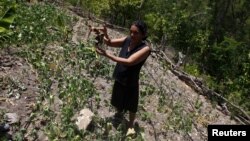In the heart of Honduras' notorious "Dry Corridor," the most important harvest for farmer Daniel Cruz Castro is rainwater.
The construction of a reservoir and irrigation system means he no longer worries the soil will become parched and the crops his family depends on will shrivel.
Rainwater harvesting allows the 12 families in his farming collective to grow crops throughout most of the year, and sell more lucrative products such as watermelon and green beans on the local market, he explained, boosting their incomes and standards of living despite harsh droughts.
"For producers like ourselves, this reservoir energizes us," said Cruz, 46, by telephone from Moraicito, near Nacaome in western Honduras.
"We're happy, we're content — there's water, there's life and we have more security," said the father of two.
His brother, like thousands of Hondurans each year, made the perilous trek north to try his luck in the United States. He is now back earning a living on the 8-hectare (20-acre) collective farm and has no intention of migrating again, said Cruz.
The Honduran government is planning to build hundreds of rainwater harvesting systems each year.
These capture and store the rain that falls during the wet season in reservoirs, which are usually linked to drip irrigation systems that allow farmers to harvest up to three crops instead of one, easing poverty and chronic food insecurity.
Improving prospects for rural communities, particularly in the Dry Corridor, where many subsistence farmers struggle to produce food through consecutive years of drought, may also help stem the flow of migrants from Honduras, one of the world's most dangerous countries where a third of people live on less than a dollar a day.
To maximize the benefit of the downpours captured in the rainy season, the reservoirs need to be teamed with drip irrigation and technical programs, alongside tree-planting projects to protect watersheds, said Milton Funes, technical director for Global Communities, who helped develop rainwater harvesting systems in Honduras, including in Moraicito.
"The rain cycles are so hectic ... so this is kind of opening the tap whenever there's no water coming from the sky," he said.
Green water
Funes expects an upcoming randomized control trial on water harvesting projects to show that increased production leads to healthier, more educated communities that are better prepared for climate change and less likely to lose people to "an American dream up north."
Rainwater harvesting projects are enabling small-scale farmers to branch out from their traditional maize and beans to grow fruit and vegetables they can sell, according to the Secretariat of Agriculture and Livestock (SAG) in Honduras.
It is working with U.S. development agency USAID on the scheme, and taking technical advice on reservoir building from the U.S. Army Corps of Engineers.
"They're moving away from a traditional system of sowing maize in May and June ... they're diversifying production [and] these products are more lucrative and give a better return," said Juan Carlos Colindres, irrigation director at SAG.
One hectare integrated with irrigation provides permanent work for five people, he added, estimating that a 40,000-cubic-meter reservoir costs around $15,000 to build.
To speed up the reservoir roll-out safely, Honduran technicians are using a geographic information system-based technology called AGRI to analyze topography and determine the best places to capture rainfall and run-off, instead of spending weeks walking around to scout locations.
"Conventionally people just take water from streams – what we call blue water," said Marcela Quintero, ecosystems theme leader at the International Center for Tropical Agriculture (CIAT) in Colombia, which developed AGRI.
"They don't take advantage of the green water that falls through precipitation; they haven't captured and stored it for the season when they need it most," she said.
Giant bags
To cut the cost and expertise needed to build reservoirs, one project in Honduras is capturing rainwater using giant geomembrane bags that come with a $1,000 price tag and can be easily transported to rural areas where they store up to 25,000 liters and link to irrigation systems.
"This technology increases their storage capacity and gives them a source of water in times when they couldn't have any production at all," said Fabiola Tabora Merlo, regional coordinator for the Global Water Partnership, which is helping pilot the project among vegetable farmers near Tegucigalpa. "It increases their resilience to climate change."
Experts say Honduras' rainwater-harvesting projects could be exported to other countries with a similar climate, geography and farming culture.
Global Communities' Funes said the approach could ease pressure to migrate by creating local economic opportunities, while improving the environment and "creating consciousness about the importance of water which is so much needed all over the world."








